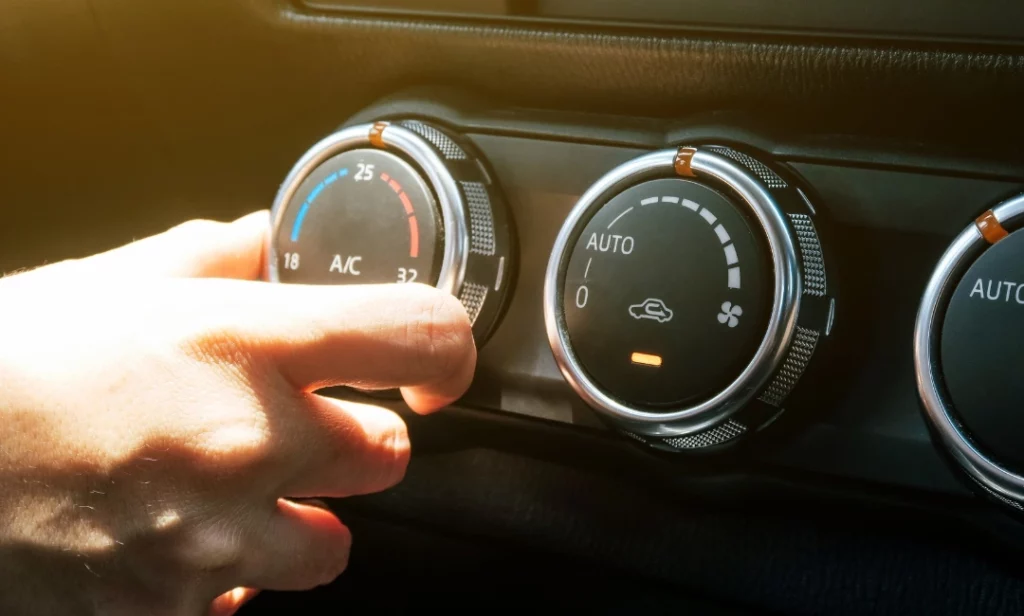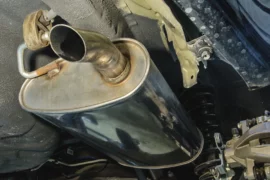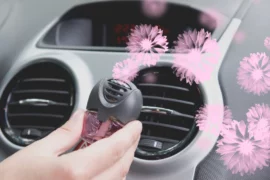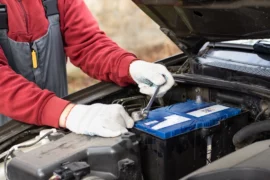Feeling cold air from your car’s heater on a chilly day isn’t just unpleasant; it could be a sign of a problem with your vehicle’s engine. If the heater isn’t producing warm air, it might be due to issues with the cooling system, thermostat, or airflow.
If your car’s heater isn’t warming up, cold air is coming from the vents, or there’s no heat at all, this guide breaks down the possible causes, simple fixes you can try yourself, estimated repair costs, and when it’s best to call a professional.
How the Car Heater Works?
Before we look into why your car heater is blowing cold air, it’s helpful to understand how the system works. The heater depends on the engine’s cooling system. As the engine runs, it produces heat, which is absorbed by the coolant and carried through a small radiator called the heater core, located behind the dashboard.
When you turn on the heat, a fan pushes air over the hot heater core, warming it before it enters the cabin. The thermostat controls engine temperature to ensure the coolant gets warm enough to heat the car.
If the coolant is low, the thermostat is faulty, or the heater core is blocked, warm airflow can stop, causing cold air to come from the vents instead of heat. Understanding this process makes it easier to spot heating issues.
7 Things That Can Make Your Car Heater Blow Cold Air
If your car heater is blowing cold air even after the engine warms up, there’s likely a problem with the heating system. Here are the most common reasons, along with car bad symptoms and simple solutions.
1. Low Coolant Levels
If the coolant is too low, hot fluid may not reach the core. You might notice the engine overheating, a coolant warning light, or cold air coming from the vents when you turn on the heat. To fix a car heater blowing cold air, add the right type of coolant. If the level keeps dropping, there may be a leak or a faulty radiator cap. That’s usually why the heater blows cold.
2. Faulty Thermostat
If the thermostat is stuck open, the engine may not get hot enough to produce cabin heat. You might notice the temperature gauge stays low, the heater takes longer to warm up, or it blows cold air at idle. Replacing the thermostat usually usually fixes the heating problem. Replacing the thermostat usually costs between $150 and $300.
3. Clogged or Leaking Heater Core
A clogged or leaking heater core can stop hot coolant from flowing through the system. Look for a sweet smell, fogged-up windows, or wet carpets. Flushing the system may clear blockages, but a leaking core usually needs replacement. In some cases, it’s best to visit a mechanic for heater repair.
4. Air Trapped in the Cooling System
Air bubbles in the cooling system can stop the coolant from flowing properly, which prevents heat from reaching the vents. You might notice gurgling noises, uneven heating, or engine overheating after working on the coolant system. To fix a car heater blowing cold air, bleed the system to remove trapped air and restore smooth coolant flow.
5. Broken Heater Control Valve
This valve manages how much hot coolant goes to the heater core. If it gets stuck closed, you won’t get heat, even when the engine is warm. If the heater works off and on, replacing the valve is usually the fix.
6. Blend Door Actuator Problems
The blend door actuator mixes hot and cold air. If it fails, you might notice clicking sounds, uneven vent temperatures, or have the air stuck on cold. Replacing the actuator usually fixes the issue, but getting to it may involve removing part of the dashboard.
7. Cold Weather and Short Trips
In very cold weather, short trips might not let the engine warm up enough to produce heat. Letting the engine idle for a few minutes can help, or using a block heater in very cold conditions can warm up the engine more quickly.
Suggestion: Learn How to Wash Your Car Like a Pro at Home.
How to Fix a Car Heater Blowing Cold Air? DIY Tips

If your car’s heater isn’t warming up, the first thing to check is the coolant level. Low coolant is often the reason. Wait until the engine is cool, then add the correct type of coolant.
Next, try to bleed the cooling system. Some cars have a bleeder valve. If not, park on a slight slope, remove the cap, and let the engine run for a short time to get rid of air bubbles.
To fix a car heater blowing cold air, you can also reset the blend door actuator. Turn on the ignition and move the temperature control from hot to cold. In some cars, disconnecting the battery might reset it. If these steps don’t work, visit a mechanic for heater repair.
There could be a clogged heater core, a stuck valve, or a faulty thermostat. A coolant flush might help if the system is blocked. Replacing a faulty thermostat typically costs between $150 and $300.
DIY methods may fix small problems, but for bigger issues, it’s best to get a professional diagnosis.
How Much Does It Cost to Repair?
If your car’s heater is blowing cold air, the cost to fix it depends on what’s causing the problem. Here’s a breakdown of common issues and their estimated repair costs.
| Problem | Estimated Cost |
| Thermostat replacement | $150 – $300 |
| Coolant flush | $100 – $150 |
| Heater core replacement | $500 – $1,000+ |
| Blend door actuator | $200 – $350 |
| Heater control valve | $150 – $250 |
A faulty thermostat or low coolant is often the reason cold air comes from the heater, and these repairs tend to be more affordable. However, a clogged heater core or a broken blend door actuator usually costs more due to labor time and part pricing.
The cost of repairs can also change based on your car’s make, model, and local labor rates. It’s smart to get a written estimate before approving any repairs, especially if the heating issue seems serious.
Related: Which Ford SUV Leads the Pack in Fuel Efficiency for 2025?
Winter Maintenance Tips to Avoid Heating Issues

To make sure your car heater works properly in winter, follow these important steps:
Check your coolant level every month, low coolant is one of the most common reasons a car heater blows cold air. If your thermostat is old or faulty, replace it so heat flows correctly when you need it most.
Flush your coolant system every 2 to 3 years to prevent rust and clogs.
Inspect radiator hoses and belts regularly for signs of wear or damage.
Run your heater at least once a week during cold months to keep internal components in good shape. This helps prevent valves and blend doors from sticking due to lack of use.
Caring for your car’s heating system ahead of time reduces the chance of your car heater blowing cold air, avoids costly repairs, and keeps your winter drives comfortable.
Also Check: DIY vs Valvoline Oil Change: Which One Wins?
Final Check to Keep Your Heater Working All Winter
A car heater blowing cold air is a common problem, especially during colder weather. Most causes like low coolant levels, a faulty thermostat, or a clogged heater core can be identified and fixed with basic knowledge. Routine checks and simple steps, like flushing the coolant system every few years and inspecting heater components, help prevent future issues.
If you’ve already tried easy fixes like topping off coolant or adjusting the blend door but the heater still doesn’t work, it may be time to visit a mechanic for a full inspection. Some fixes, like replacing the heater core or blend door actuator, need special tools and some know-how.
Regular maintenance helps your car’s heating system run reliably and reduces the chance of your car heater blowing cold air again. Taking care of small issues early can help you avoid bigger costs and keep your car warm during the winter.
FAQ’s
1. Why is my car blowing cold air when the heater is on?
Your car might be blowing cold air because there’s not enough coolant, the thermostat is stuck open, or there’s a problem with the heater core or blend door. These problems can stop the hot coolant from getting to the heater core, which means the air stays cool.
2. How do I fix my car heater that blows cold air?
First, check the coolant level when the engine is cool and add more if needed. You may also need to remove any air trapped in the cooling system. If that doesn’t fix the problem, inspect the thermostat, heater control valve, and blend door actuator. If you’re not sure what’s causing the problem, it’s a good idea to let a mechanic inspect the system.
3. Can low coolant cause no heat in the car?
Yes, low coolant is one of the most common reasons a car heater stops working. Without enough coolant flowing through the system, the heater core doesn’t get the hot fluid it needs to warm the air inside the car.
4. How much does it cost to fix a car heater blowing cold air?
The cost to fix the problem depends on what’s wrong and the condition of your car. If the thermostat needs to be replaced, it usually costs between $150 and $300. A coolant flush is usually less expensive, around $100 to $150. If the heater core is damaged and needs replacement, it can cost $500 to $1,000 or more, mostly due to labor.
Replacing a blend door actuator generally costs $200 to $350, and a heater control valve usually falls between $150 and $250. Overall repair costs can vary based on your car’s make, model, and local labor rates.
5. What are signs of a bad heater core?
Look for signs like a sweet smell inside the car, foggy windows, or damp carpets, these could indicate a leaking heater core. If the core is blocked, you might not get warm air from the vents, even when the engine is fully warmed up.
6. Can I drive my car if the heater is blowing cold air?
You can drive the car, but it depends on what’s causing the problem. If it’s just a stuck blend door or air in the system, it’s usually safe to continue driving. However, if the issue is due to low coolant or an overheating engine, driving further could cause serious engine damage.







